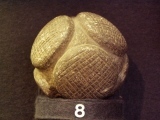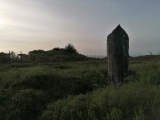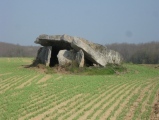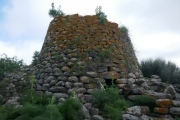Andy Burnham's Blog, page 133
August 5, 2022
Dolmens de Counezeil
Paza, Rouffiac-des-Corbières, Narbonne, Aude, Languedoc-Roussillon-Midi-Pyrénées Information and Pictures: The IGN maps show this site in Languedoc:Aude with the symbol of a menhir, but it is definitely a series of at least three dolmens and is referred to as such by the archaeological authorities in the region that marked the path. The three dolmens in a quarter of a circle formation near the top of a ridge probably led the locals to refer to it as a cromlech. The first dolmen is a quite degraded dolmen about 4 meters long where the stones slipped into each other. It has a North west by South East orientation.
Published on August 05, 2022 07:21
August 4, 2022
Mura Fratta Protonuraghe
Protonuraghe Mura Fratta is a relatively well-preserved corridor nuraghe located few meters south of the nearby farmstead. The main corridor with entrances at both ends survived in good condition. Around the protonuraghe there are distinguishable remains of a settlement.
Published on August 04, 2022 11:03
August 3, 2022
Schalenstein von Heerstedt
Cup marked glacial erratic in Lower Saxony. CharcoalBurner writes: Through my research around the Heerstedt stone cist, I became aware of this cup marked stone through talking to local people. It was discovered a few years ago near Heerstedt. After the find, the stone was set up next to the parking area of the local potato shop.
Published on August 03, 2022 00:39
August 2, 2022
King's Museum
New Open Access ebook (and print book): The Circular Archetype in Microcosm: The Carved Stone Balls of Late Neolithic Scotland by Chris Stewart-Moffitt, details in our forum. Kings Museum lies at the heart of the University of Aberdeen's campus in Old Aberdeen. It moved to its new location in 2013. As well as being Scotland's newest museum, it may also be the oldest as its origins lie in a museum collection - formerly the Marischal Museum - established in King's College in 1727.
Published on August 02, 2022 09:41
Dry Tree Menhir
The impressive Dry Tree Menhir stands just outside the fences of the Goonhilly Downs Earth Station, on the Lizard peninsula. It can be walked to on well made paths from the nearby nature reserve carpark.
Published on August 02, 2022 04:14
August 1, 2022
Dolmen de la Pagerie
This monster dolmen can be found a few hundred metres up the GR.3 footpath from near the farm of the same name, just to the southwest of Gennes, in Maine et Loire. It is just one of the enormous dolmens they have around here (see our nearby sites list), with the main chamber being 10 metres long by 5 metres wide, made using enormous slabs of the sarsen like rock.
Published on August 01, 2022 14:47
Louden Hill Cairn
The Historic England entry for this site refers to a cairn and also a nearby medieval structure. There is indeed a cairn and also an impressive medieval long house. The photo here is of the cairn, which seems to have an unrecorded cist within it.
Published on August 01, 2022 03:59
July 31, 2022
Sanilo Nuraghe
Nuraghe in Sardinia (Sardegna). Nuraghe Sanilo is located near the local road from Sedilo to Aidomaggiore. It is a complex nuraghe with well-preserved main tower. Inside the latter there is an intact tholos chamber and partly preserved intra-mural staircase. Around the main tower there are distinguishable remains of a bastion.
Published on July 31, 2022 15:04
Schwedenspeicher-Museum
Museum in Stade, Lower Saxony, Bremen. Located in the middle of the old town, right by the old port, about 10 minutes' walk from the train station.
Published on July 31, 2022 09:27
July 29, 2022
Long Man Hill Cuttings
A walk to find out the size of the world (yes really). 6th August near Eastbourne. Exploring the hill cuttings and flint mines around the Long Man of Wilmington hill figure with Jon Morris, author of Stonehenge: Solving the Neolithic Universe. See the comments on our page for more.. This site consists of five cuttings or Arena, it is not clear from when these features date from. Arena A is the largest - the coordinates given locate the centre of this - its entry is directly north of the larger of the two tumuli immediately to the south.
Published on July 29, 2022 05:52













